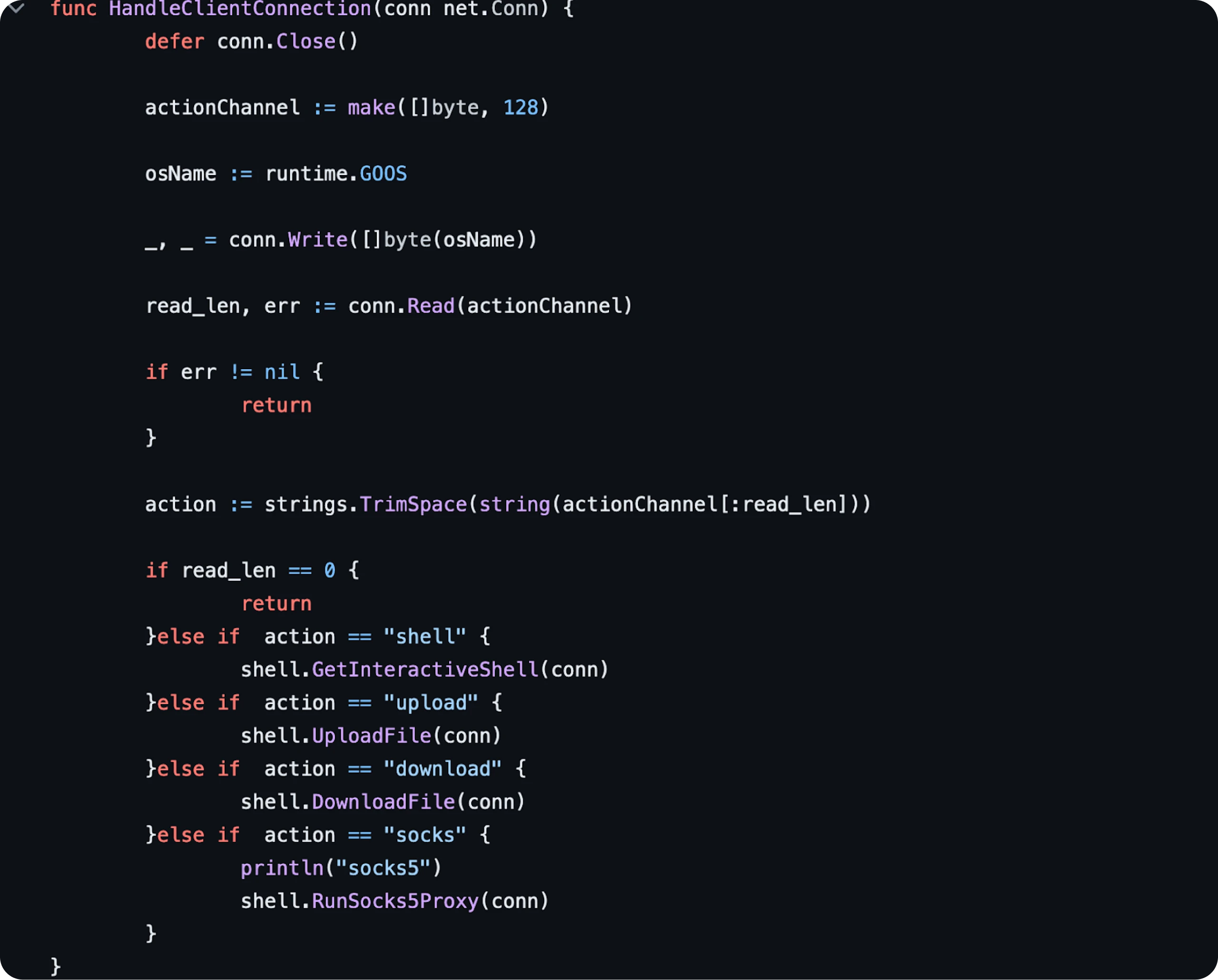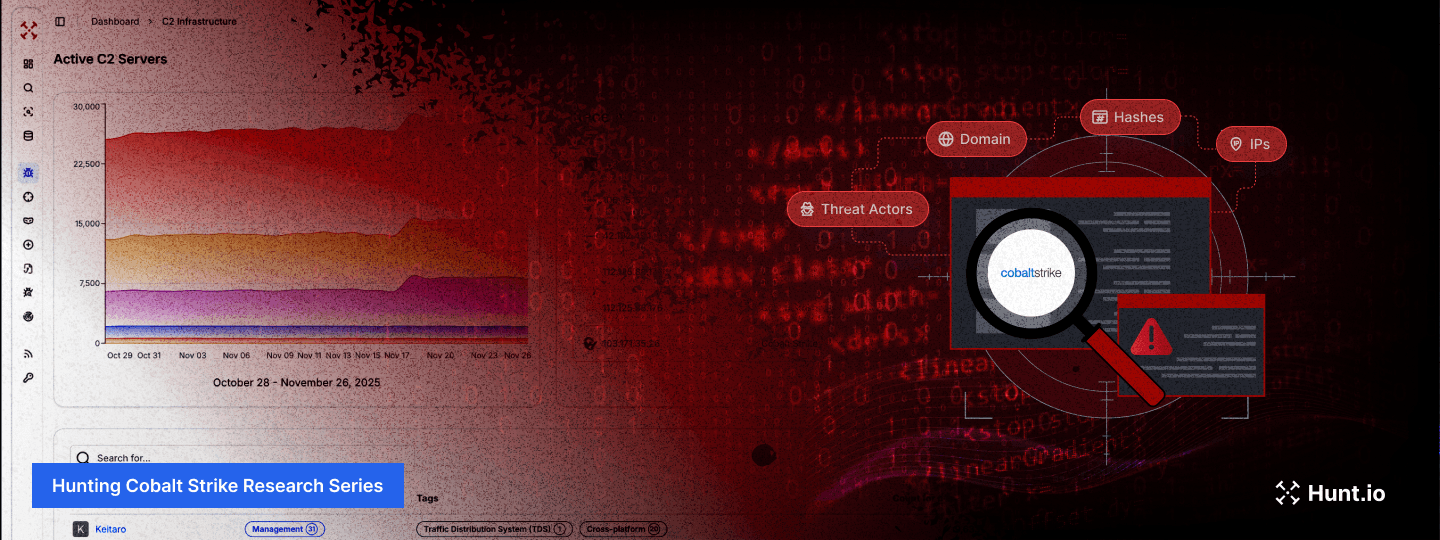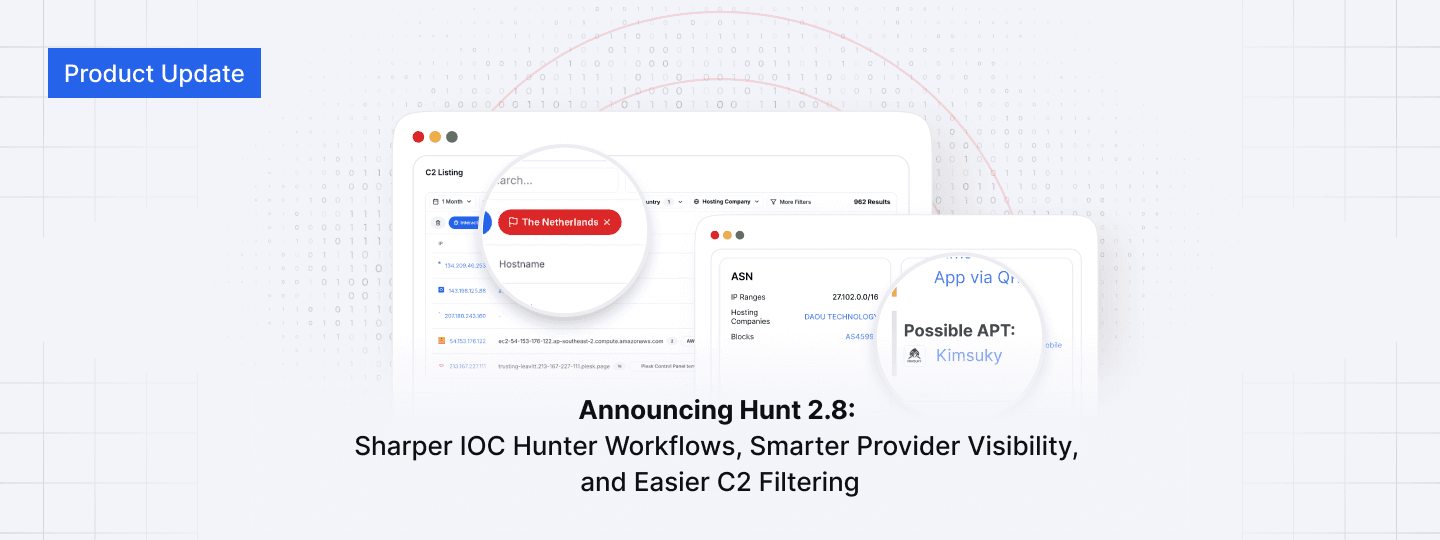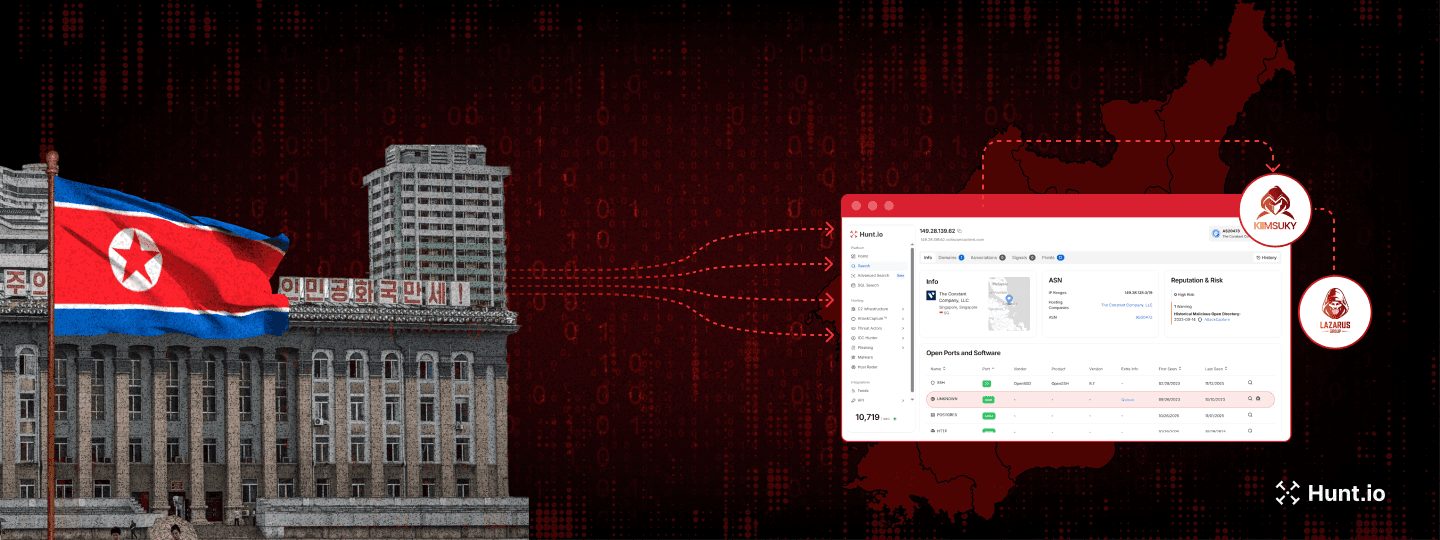BlueShell: Four Years On, Still A Formidable Threat
Published on
Published on
Published on
Apr 9, 2024
Apr 9, 2024
Apr 9, 2024





Introduction
Platforms like GitHub offer a valuable resource for developers and the open-source community. However, these sites also create a potential avenue for threat actors to distribute malicious tools.
This week, we're turning our attention to BlueShell, an open-source backdoor hosted on GitHub for about four years but still seeing plenty of use by attackers in 2024. In this post, we'll highlight some recent BlueShell servers and look at an interesting ELF binary pulled from a sandbox.
What Makes BlueShell Special?
Honestly, not a lot. Written in Golang, the tool allows users to compile client binaries that run on Windows, Linux, and Mac operating systems. The server communicates with victim systems over TCP sockets and encrypts messages using TLS. The default version of BlueShell includes four features:
Shell → Run commands on the victim system
Upload → Upload files
Download → Download files
Socks → Use a Socks5 proxy (hardcoded credentials: blue/Blue@2020)
 Figure 1: BlueShell GitHub repository
Figure 1: BlueShell GitHub repositoryBlueShell also comes with a TLS certificate. Contrary to common assumptions, attackers frequently utilize these well-known certificates. This approach helps them blend in and potentially deceive defenders.
 Figure 2: BlueShell default install TLS certificate
Figure 2: BlueShell default install TLS certificateFurthermore, switching to a different certificate is an effective strategy for misleading defenders and researchers. Such a change can significantly alter the attack's digital footprint, adding a layer of complexity to research and threat intelligence efforts.
The server IP address, listening port, and delay interval are hard-coded, constituting the core configuration data for the attacker-controlled infrastructure. While BlueShell may resemble many open-source frameworks in functionality, albeit with a more streamlined feature set, its unique aspects should not be underestimated. Notably, AhnLab stands as the sole security vendor to have published reports on incidents involving this backdoor to date.
According to insights from AhnLab, the BlueShell backdoor has predominantly targeted organizations within South Korea and Thailand, spanning various industry verticals. This pattern of targeting aligns with the operational profile of Dalbit, a threat group believed to originate from China and the only threat actor publicly associated with the deployment of BlueShell in an attack campaign.
BlueShell Servers We're Currently Tracking
Tracking adversary infrastructure presents formidable challenges. For this post, our focus narrows to Command and Control (C2) servers utilizing BlueShell's default TLS certificate. Our methodology extends beyond a single IOC; we also consider unconventional port usage, specifically targeting non-HTTP services, as BlueShell typically operates over TCP sockets.
In identifying malicious servers, it's crucial to integrate findings with third-party intelligence sources, such as VirusTotal, and consider factors like the C2 infrastructure's geographic location and service provider.
The following presents a selection of the servers monitored at Hunt:
| IP | ASN | Location | C2 Port |
|---|---|---|---|
| 8.218.243[.]239 | Alibaba (US) Technology Co. Ltd | HK | 8443 |
| 103.140.186[.]8 | ESTNOC-Global | SG | 58091 |
| 141.98.212[.]34 | ESTNOC-Global | HK | 58091 |
| 204.194.65[.]48 | Cloudie | HK | 8443 |
| 39.98.81[.]60 | Hangzhou Alibaba Advertising Co., Ltd. | CN | 8091 |
| 39.98.91[.]83 | Hangzhou Alibaba Advertising Co., Ltd. | CN | 8088 8091 |
Table 1: IPs tracked by Hunt
It should be noted that attackers can easily modify server ports and certificates. By publication, some or all of the IP addresses listed could no longer host the indicators we used to locate them.
An SSL history feature like the one on the Hunt platform (shameless plug) might reveal patterns in how malware campaigns evolve or how attackers attempt to renew their resources to evade detection.
As we conclude, I'll briefly cover a customized BlueShell ELF sample, hopefully providing further insight into this threat.
Brief Analysis: Customized BlueShell
Our examination subject is a stripped 64-bit ELF executable with a file size of 7.7 MB. The file communicates with one previously mentioned C2, 8.218.243[.]239.
 Figure 3: BlueShell sample in VT
Figure 3: BlueShell sample in VT Figure 4: C2 server in Hunt
Figure 4: C2 server in Hunt| Filename | UNK/5dc72a9b98b3293f10e294c4fc7a6881776c38e8bf2d8ed6073dea5c773927fd.00_00753000.elf |
| File size | 7.7 MB |
| Go Version | 1.18.9 |
| Go Build ID | B5yLEwnnoNjgqDUlEAGr/be1BqzAQ7idhTJKOBogT/fNaVXhqoIBUKR5w6cBcN/FCIOcnNY1ZV0uPxOTuAN |
| MD5 | 7d960f77fda453c8f0c7f6c7448a35b4 |
| SHA1 | ee0257a6645aca2232ad270f2c08ac6b1b9cfc68 |
| SHA256 | 5dc72a9b98b3293f10e294c4fc7a6881776c38e8bf2d8ed6073dea5c773927fd |
| C2 | 8.218.243[.]239:8443 |
Table 2: File details
An intriguing aspect of this sample is the inclusion of an embedded image. This image shows a woman presenting at a seminar at Atomy, specifically the China branch. Atomy is a South Korean company specializing in direct selling and network marketing.
The relevance of this image to the file remains a mystery, as there is no current evidence suggesting Atomy is being directly targeted with BlueShell. Including a seemingly unrelated image in the malware raises more questions than answers about the actor's intentions.
 Figure 5: Image found within the executable
Figure 5: Image found within the executableThis sample shares many of the same features (besides the image) as the repository code, with a few exceptions. As discussed earlier, BlueShell uses just three parameters (IP, Port, Wait Time) for its configuration. In this case, the actor added a client key (B1ueShe11-client) and a client token (B1uekT0k3n-client), likely used for session management of the application.
 Figure 6: Snippet of BlueShell Configuration Values in Ghidra
Figure 6: Snippet of BlueShell Configuration Values in Ghidra Figure 7: BlueShell GitHub source code configuration data
Figure 7: BlueShell GitHub source code configuration dataThe actor significantly enhanced BlueShell's capabilities by integrating file server and reverse shell functionality with the tool's standard features. These augmentations to the backdoor code signify a deliberate move to increase its versatility and effectiveness in targeted operations.
 Figure 8: Decompiled code in Ghidra displaying customized features
Figure 8: Decompiled code in Ghidra displaying customized features Figure 9: Snippet of standard BlueShell source code
Figure 9: Snippet of standard BlueShell source codeFinally, the file uses a hardcoded password check before starting a service and executing commands specific to system utilities. If the check fails, the server starts normally without additional operations. The code checks for a string length of 8 and uses the hexadecimal representation of the reverse of the word 'password.'
 Figure 10: Snippet of decompiled code consisting of a password check
Figure 10: Snippet of decompiled code consisting of a password checkConclusion
In conclusion, we briefly examined the BlueShell backdoor, a tool that has been around for more than four years and will likely be used in the foreseeable future. From the surprising inclusion of an image from an Atomy China seminar to the added functionalities of a file server and reverse shell, we identified how attackers are extending open-source projects to meet their needs.
Apply for an account today to discover more intriguing hosted malware examples, access our near-real-time feed of command-and-control infrastructure data, and use our scanners to look for suspicious IP addresses.

Introduction
Platforms like GitHub offer a valuable resource for developers and the open-source community. However, these sites also create a potential avenue for threat actors to distribute malicious tools.
This week, we're turning our attention to BlueShell, an open-source backdoor hosted on GitHub for about four years but still seeing plenty of use by attackers in 2024. In this post, we'll highlight some recent BlueShell servers and look at an interesting ELF binary pulled from a sandbox.
What Makes BlueShell Special?
Honestly, not a lot. Written in Golang, the tool allows users to compile client binaries that run on Windows, Linux, and Mac operating systems. The server communicates with victim systems over TCP sockets and encrypts messages using TLS. The default version of BlueShell includes four features:
Shell → Run commands on the victim system
Upload → Upload files
Download → Download files
Socks → Use a Socks5 proxy (hardcoded credentials: blue/Blue@2020)
 Figure 1: BlueShell GitHub repository
Figure 1: BlueShell GitHub repositoryBlueShell also comes with a TLS certificate. Contrary to common assumptions, attackers frequently utilize these well-known certificates. This approach helps them blend in and potentially deceive defenders.
 Figure 2: BlueShell default install TLS certificate
Figure 2: BlueShell default install TLS certificateFurthermore, switching to a different certificate is an effective strategy for misleading defenders and researchers. Such a change can significantly alter the attack's digital footprint, adding a layer of complexity to research and threat intelligence efforts.
The server IP address, listening port, and delay interval are hard-coded, constituting the core configuration data for the attacker-controlled infrastructure. While BlueShell may resemble many open-source frameworks in functionality, albeit with a more streamlined feature set, its unique aspects should not be underestimated. Notably, AhnLab stands as the sole security vendor to have published reports on incidents involving this backdoor to date.
According to insights from AhnLab, the BlueShell backdoor has predominantly targeted organizations within South Korea and Thailand, spanning various industry verticals. This pattern of targeting aligns with the operational profile of Dalbit, a threat group believed to originate from China and the only threat actor publicly associated with the deployment of BlueShell in an attack campaign.
BlueShell Servers We're Currently Tracking
Tracking adversary infrastructure presents formidable challenges. For this post, our focus narrows to Command and Control (C2) servers utilizing BlueShell's default TLS certificate. Our methodology extends beyond a single IOC; we also consider unconventional port usage, specifically targeting non-HTTP services, as BlueShell typically operates over TCP sockets.
In identifying malicious servers, it's crucial to integrate findings with third-party intelligence sources, such as VirusTotal, and consider factors like the C2 infrastructure's geographic location and service provider.
The following presents a selection of the servers monitored at Hunt:
| IP | ASN | Location | C2 Port |
|---|---|---|---|
| 8.218.243[.]239 | Alibaba (US) Technology Co. Ltd | HK | 8443 |
| 103.140.186[.]8 | ESTNOC-Global | SG | 58091 |
| 141.98.212[.]34 | ESTNOC-Global | HK | 58091 |
| 204.194.65[.]48 | Cloudie | HK | 8443 |
| 39.98.81[.]60 | Hangzhou Alibaba Advertising Co., Ltd. | CN | 8091 |
| 39.98.91[.]83 | Hangzhou Alibaba Advertising Co., Ltd. | CN | 8088 8091 |
Table 1: IPs tracked by Hunt
It should be noted that attackers can easily modify server ports and certificates. By publication, some or all of the IP addresses listed could no longer host the indicators we used to locate them.
An SSL history feature like the one on the Hunt platform (shameless plug) might reveal patterns in how malware campaigns evolve or how attackers attempt to renew their resources to evade detection.
As we conclude, I'll briefly cover a customized BlueShell ELF sample, hopefully providing further insight into this threat.
Brief Analysis: Customized BlueShell
Our examination subject is a stripped 64-bit ELF executable with a file size of 7.7 MB. The file communicates with one previously mentioned C2, 8.218.243[.]239.
 Figure 3: BlueShell sample in VT
Figure 3: BlueShell sample in VT Figure 4: C2 server in Hunt
Figure 4: C2 server in Hunt| Filename | UNK/5dc72a9b98b3293f10e294c4fc7a6881776c38e8bf2d8ed6073dea5c773927fd.00_00753000.elf |
| File size | 7.7 MB |
| Go Version | 1.18.9 |
| Go Build ID | B5yLEwnnoNjgqDUlEAGr/be1BqzAQ7idhTJKOBogT/fNaVXhqoIBUKR5w6cBcN/FCIOcnNY1ZV0uPxOTuAN |
| MD5 | 7d960f77fda453c8f0c7f6c7448a35b4 |
| SHA1 | ee0257a6645aca2232ad270f2c08ac6b1b9cfc68 |
| SHA256 | 5dc72a9b98b3293f10e294c4fc7a6881776c38e8bf2d8ed6073dea5c773927fd |
| C2 | 8.218.243[.]239:8443 |
Table 2: File details
An intriguing aspect of this sample is the inclusion of an embedded image. This image shows a woman presenting at a seminar at Atomy, specifically the China branch. Atomy is a South Korean company specializing in direct selling and network marketing.
The relevance of this image to the file remains a mystery, as there is no current evidence suggesting Atomy is being directly targeted with BlueShell. Including a seemingly unrelated image in the malware raises more questions than answers about the actor's intentions.
 Figure 5: Image found within the executable
Figure 5: Image found within the executableThis sample shares many of the same features (besides the image) as the repository code, with a few exceptions. As discussed earlier, BlueShell uses just three parameters (IP, Port, Wait Time) for its configuration. In this case, the actor added a client key (B1ueShe11-client) and a client token (B1uekT0k3n-client), likely used for session management of the application.
 Figure 6: Snippet of BlueShell Configuration Values in Ghidra
Figure 6: Snippet of BlueShell Configuration Values in Ghidra Figure 7: BlueShell GitHub source code configuration data
Figure 7: BlueShell GitHub source code configuration dataThe actor significantly enhanced BlueShell's capabilities by integrating file server and reverse shell functionality with the tool's standard features. These augmentations to the backdoor code signify a deliberate move to increase its versatility and effectiveness in targeted operations.
 Figure 8: Decompiled code in Ghidra displaying customized features
Figure 8: Decompiled code in Ghidra displaying customized features Figure 9: Snippet of standard BlueShell source code
Figure 9: Snippet of standard BlueShell source codeFinally, the file uses a hardcoded password check before starting a service and executing commands specific to system utilities. If the check fails, the server starts normally without additional operations. The code checks for a string length of 8 and uses the hexadecimal representation of the reverse of the word 'password.'
 Figure 10: Snippet of decompiled code consisting of a password check
Figure 10: Snippet of decompiled code consisting of a password checkConclusion
In conclusion, we briefly examined the BlueShell backdoor, a tool that has been around for more than four years and will likely be used in the foreseeable future. From the surprising inclusion of an image from an Atomy China seminar to the added functionalities of a file server and reverse shell, we identified how attackers are extending open-source projects to meet their needs.
Apply for an account today to discover more intriguing hosted malware examples, access our near-real-time feed of command-and-control infrastructure data, and use our scanners to look for suspicious IP addresses.
Related Posts:
Get biweekly intelligence to hunt adversaries before they strike.
Latest News
Hunt Intelligence, Inc.
Get biweekly intelligence to hunt adversaries before they strike.
Latest News
Hunt Intelligence, Inc.
Get biweekly intelligence to hunt adversaries before they strike.
Latest News
Hunt Intelligence, Inc.







